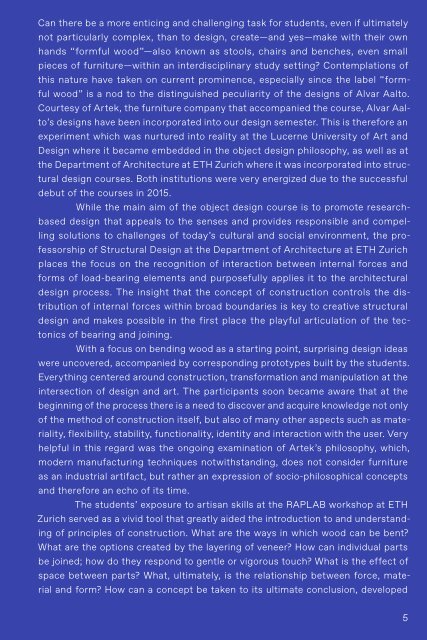Formful Wood. Explorative Furniture
ISBN 978-3-86859-588–8 https://www.jovis.de/de/buecher/product/formful-wood-explorative-furniture.html
ISBN 978-3-86859-588–8
https://www.jovis.de/de/buecher/product/formful-wood-explorative-furniture.html
You also want an ePaper? Increase the reach of your titles
YUMPU automatically turns print PDFs into web optimized ePapers that Google loves.
Can there be a more enticing and challenging task for students, even if ultimately<br />
not particularly complex, than to design, create—and yes—make with their own<br />
hands “formful wood”—also known as stools, chairs and benches, even small<br />
pieces of furniture—within an interdisciplinary study setting? Contemplations of<br />
this nature have taken on current prominence, especially since the label “formful<br />
wood” is a nod to the distinguished peculiarity of the designs of Alvar Aalto.<br />
Courtesy of Artek, the furniture company that accompanied the course, Alvar Aalto’s<br />
designs have been incorporated into our design semester. This is therefore an<br />
experiment which was nurtured into reality at the Lucerne University of Art and<br />
Design where it became embedded in the object design philosophy, as well as at<br />
the Department of Architecture at ETH Zurich where it was incorporated into structural<br />
design courses. Both institutions were very energized due to the successful<br />
debut of the courses in 2015.<br />
While the main aim of the object design course is to promote researchbased<br />
design that appeals to the senses and provides responsible and compelling<br />
solutions to challenges of today’s cultural and social environment, the professorship<br />
of Structural Design at the Department of Architecture at ETH Zurich<br />
places the focus on the recognition of interaction between internal forces and<br />
forms of load-bearing elements and purposefully applies it to the architectural<br />
design process. The insight that the concept of construction controls the distribution<br />
of internal forces within broad boundaries is key to creative structural<br />
design and makes possible in the first place the playful articulation of the tectonics<br />
of bearing and joining.<br />
With a focus on bending wood as a starting point, surprising design ideas<br />
were uncovered, accompanied by corresponding prototypes built by the students.<br />
Everything centered around construction, transformation and manipulation at the<br />
intersection of design and art. The participants soon became aware that at the<br />
beginning of the process there is a need to discover and acquire knowledge not only<br />
of the method of construction itself, but also of many other aspects such as materiality,<br />
flexibility, stability, functionality, identity and interaction with the user. Very<br />
helpful in this regard was the ongoing examination of Artek’s philosophy, which,<br />
modern manufacturing techniques notwithstanding, does not consider furniture<br />
as an industrial artifact, but rather an expression of socio-philosophical concepts<br />
and therefore an echo of its time.<br />
The students’ exposure to artisan skills at the RAPLAB workshop at ETH<br />
Zurich served as a vivid tool that greatly aided the introduction to and understanding<br />
of principles of construction. What are the ways in which wood can be bent?<br />
What are the options created by the layering of veneer? How can individual parts<br />
be joined; how do they respond to gentle or vigorous touch? What is the effect of<br />
space between parts? What, ultimately, is the relationship between force, material<br />
and form? How can a concept be taken to its ultimate conclusion, developed<br />
5


















